 |
|
| |
Overview
The main features of the greater
Ontong Java Plateau (OJP) may be summarized as follows.
-
-
It is presently obducting along
the Solomon Islands trench (Figure 2) ( e.g.,
Neal
et al.,
1997).
-
It includes the Ontong Java Plateau
and neighboring basin basalts, including Nauru,
E. Mariana, possibly Pigafetta and other contemporaneous
flood basalts (Coffin & Eldholm, 2004).
-
It is the most voluminous large
igneous province (LIP) on Earth, at ~ 60 million
cubic km ( Gladczenko
et al., 1997).
-
-
It is structurally homogeneous
– there is no evidence of continental lithosphere
( Phinney
et al.,
1999).
-
-
It is geochemically homogeneous,
involving large degrees (> 30%) of batch partial
melting followed by extensive fractional crystallization
( e.g., Neal
et al.,
1997).
-
It is widely believed to have
been formed by a large mantle plume head ( e.g.,
Tarduno
et al.,
1991).
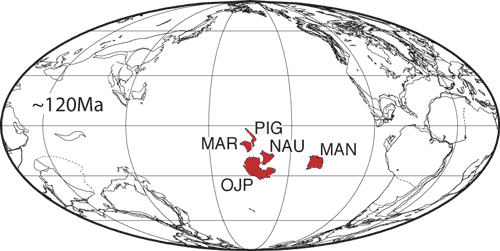
Figure 1: Plate tectonic reconstruction
for Ontong Java Plateau (OJP), Nauru (NAU), East Mariana
(MAR), Pigafetta (PIG) basin flood basalts and Manihiki
Plateau (MAN) (118.7 Ma – Chron M0: after Eldholm
& Coffin, 2000).
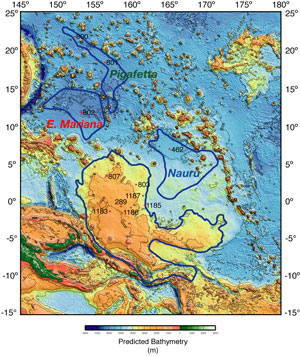
Figure 2: Predicted bathymetry
with drill sites that penetrated flood basalts
superimposed (Smith & Sandwell, 1997). Click
on figure for enlargement. |
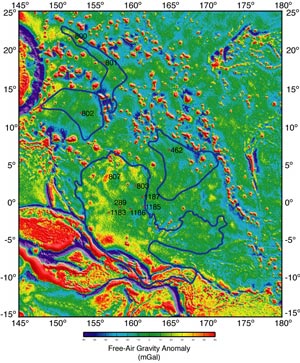
Figure 3: Satellite-derived
free-air gravity field with same drill sites as
Figure 2 superimposed (Sandwell & Smith, 1997).
Click on figure for enlargement. |
|
The predictions
of mantle plume theory vs. observations for the greater
OJP
Uplift
prior to magmatism
Widespread subaerial volcanism is predicted
to be caused by the arrival of hot, buoyant ascending
plume material at the base of the oceanic lithosphere
(Griffiths
et al.,
1989; Farnetani
& Richards,
1994; Ito
& Clift,
1998).
- Uplift of the seafloor from 1000 m to 2000 m
is predicted due to the arrival of a 1000-2000-km-diameter
plume head (Griffiths
et al.,
1989).
- Uplift of the seafloor from 3000 m to 4000 m
is predicted based on OJP-specific dynamic plume
models (Farnetani
& Richards,
1994).
- Uplift of the seafloor from 1000 m to 3000 m
is predicted based on OJP-specific isostatic plume
models (Ito
& Clift,
1998).
Observation: Actual uplift
depends on the model chosen, but it is obvious from
the data that uplift of the oceanic crust falls far
short of predictions, regardless of the wide range for
predicted uplift models (Figure 4).
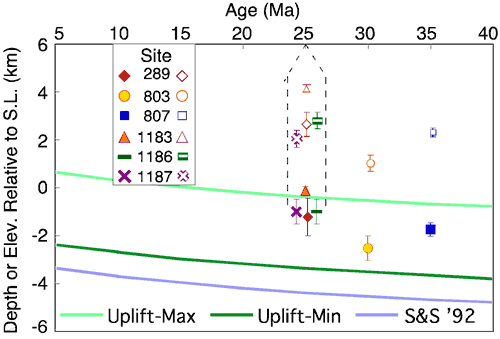
Figure 4: Model-predicted paleodepth
ranges for the top of OJP crust (open symbols) compared
to actual paleodepth ranges (filled symbols) of Aptian
sediments overlying the crust for DSDP and ODP sites.
The error bars for all data give the range based on
minimum and maximum estimates (predicted) or calculations
(actual). See Ingle
& Coffin (2004) for details.
Elevation
of emplacement
- According to simple isostasy, emplacement of
the 35-km-thick crust of the OJP following uplift
of the preexisting ~ 7-km-thick oceanic crust, should
have resulted in a minimum culminating elevation
of ~ 700 – 4200 m on the crest of the OJP
(Ingle
& Coffin,
2004).
- Significant subaerial volcanism should have been
widespread.
- Most oceanic plateaus, submarine ridges, and
seamount chains have experienced subaerial volcanism
during construction (Detrick et al., 1977;
Coffin,
1992).
Observation: All sampled OJP
basalts, both drilled & obducted, were erupted well
below sea level (Figure 5).
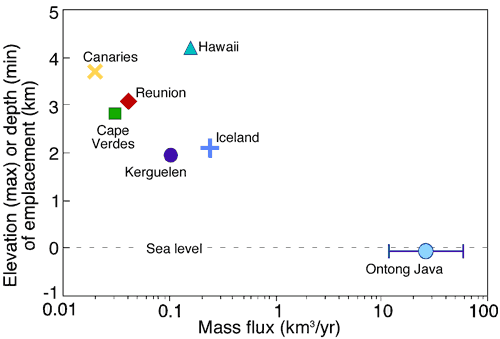
Figure 5: Mass fluxes and peak eruption
levels of currently active hot spots and the OJP. Note
that of all the hot spots, only Iceland coincides with
a mid-ocean ridge. For the OJP, the error bars represent
the mass flux range assuming an emplacement duration
of 1 - 5 Myr.
Subsidence
- Plateaus within oceanic lithosphere should subside
as a result of thermal conduction (Detrick &
Crough, 1978) or continuous viscous spreading
of the anomalous mantle material (Richards et
al., 1989) (Figure 6).
- Many oceanic plateaus and submarine ridges have
subsided in this manner (Detrick et al.,
1977; Coffin,
1992; Wallace,
2002)
- Predicted total subsidence for ~120 Ma oceanic
crust is ~3000 – ~3800 m
Observation: Based on paleoenvironments
interpreted from sediment overlying basalt (Andrews
et al., 1975; Sliter & Leckie, 1993)
and basalt eruption depths calculated from water and
carbon dioxide concentrations in basaltic glasses (Roberge
et al., 2003) it appears that the OJP crust subsided
only 1000 – 2800 m (Ingle
& Coffin, 2004) (Figure 6).
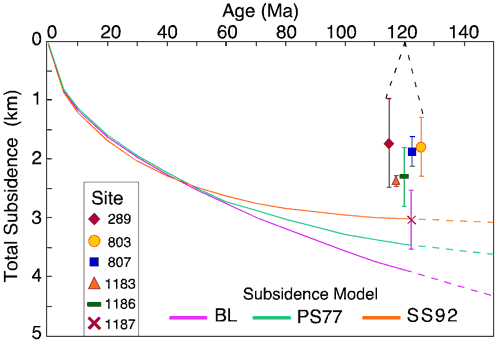
Figure 6: Total subsidence vs. age
for Ontong Java Plateau basalts (error bars on symbols
denote range) compared to lithospheric subsidence curves
from: BL and PS77 (Parsons & Sclater, 1977) and
SS92 (Stein & Stein, 1992).
Connection
to a hot spot source
- the OJP was originally proposed to have been created
by the Louisville hot spot (e.g., Tarduno
et al.,
1991).
Observation: No link to any
hot spot track or presently active hot spot can be argued
for on the basis of geochemistry (Mahoney
et al.,
1993), plate reconstructions (Neal
et al.,
1997), paleomagnetic data (Riisager
et al.,
2003), or combined hot spot motion and true polar
wander (Antretter et al., in press)
Petrogenesis
and geochemistry
The mantle plume model predicts:
- An “enriched” mantle source, preferably
isotopically comparable to one of the mantle endmembers
(e.g., EMI, EMII, HIMU).
- Large degrees of melting – melting at a
plume-ridge intersection or a “wet”
plume.
- High concentrations of elements or element isotope
ratios that reflect a possible core input (Neal
et al.,
1997).
- Noble gas data that reflect a primitive mantle
source, typically associated with the lower mantle.
Observation: Geochemical data
are ambiguous in their support for a mantle plume origin.
Isotopic compositions are intermediate between primitive
mantle and “mid-ocean ridge” or “depleted”
upper mantle compositions (e.g., Tejada
et al.,
2002). Platinum group element concentrations are
high relative to predicted values (Ely
& Neal, 2003). OJP basalts suggest low-water
contents in their mantle source (Michael,
1999) ruling out a “wet” plume.
Plume
head residue or mantle root
- Centered beneath the OJP is a 1200 km-diameter,
~ 300-km-deep mantle root, that extends well into
the asthenosphere (Richardson
et al.,
2000). It corresponds to an S-wave
velocity anomaly of ~ 5% and is less dense than
the surrounding mantle (Klosko
et al.,
2001)
- This root has been interpreted as being a “frozen
plume head” (Klosko
et al.,
2001; Gomer
& Okal,
2003)
- Depleted, restitic material may be less dense
if the extracted magmas were extremely Fe-rich but
the residue should then have the high seismic wave
speeds observed for roots beneath both Archean cratons
(Zhang & Tanimoto, 1993) and modern-day
hotspots such as Pitcairn (Rost & Williams,
2003)
Observation: The root appears
to be rheologically strong and not related to a thermal
anomaly. Its volume is far too large to be explained
by mantle material remaining after extracting the volume
needed to form the OJP basalts.
In
summary many geophysical, geodynamic, and geochemical
results from the greater OJP are at odds with
various mantle plume models for its origin. As
discussed below, we suggest that an extraterrestrial
impact model is much more consistent with existing
data and results. |
|
Would the
impact of a large meteorite explain better the observations
for the greater OJP as has been suggested for the Siberian
Traps (Jones
et al.,
2002)?
Model
parameters
- ~20 km diameter bolide of chondritic composition.
- Impact velocity ~20 km/s.
- Vertical impact assumed and instantaneous
vaporization of the ~ 4 km deep water column.
- Preexisting lithosphere thickness of ~50
km.
|
Model
results
- Penetration depth of ~ 60 km (O’Keefe
& Ahrens, 1993) and initial crater
diameter of ~ 200 km (Grieve & Pesonen,
1992) (Figure 7).
- Massive decompression melting in the upper
mantle, to a minimum depth of 300 km, assuming
100% partial melting. This results from the
removal of the lithospheric overburden.
- Solid asthenospheric mantle, moving laterally
inward and upward from below to replace the
extracted mantle may have experienced a catastrophic
decrease in pressure during its emplacement
beneath the OJP, resulting in the low shear-wave
velocities observed by Richardson
et al.
(2000).
|
|
Figure 7:
Conceptual model showing possible sequence of
events if a ~20 km-diameter bolide caused the
creation of the OJP, from the model of Jones
et al. (2002; see also Impacts
page). t=1: Moment of impact, water column
is vaporized, 20-Myr-old oceanic lithosphere (pink
layer) at impact site is obliterated, uppermost
asthenosphere is penetrated, and surrounding lithosphere
fractures; t=2: Moment of maximum penetration,
the crater is completely formed and the melting
region becomes focused; t=3: Infill of void from
bottom and sides, melt migrates out along fractures
in lithosphere, refractory surrounding mantle
fills space vacated by outflowing magmas; t=4:
~120 Ma, the OJP at the end of emplacement (pink
layer represents ~35 km thick crust); t=5: ~90
Ma, tectonism causing new pressure release melting.
Scale is maintained throughout the diagram. |
Tests
to validate an impact model
- Quantitative modeling of the impact event, including
evolution of the crater morphology, melt volumes
and compositions induced by the impact, emplacement
of the melt and OJP uplift and subsidence are critical
to validate the model.
- Spherules and highly-siderophile element anomalies
might be present in contemporaneous, local sediments.
At the time of writing, such evidence has not been
looked for.
- Discovery of distal sediments of Aptian age including
spherules, tsunamis deposits and disturbed abyssal
sediments, would help to validate this model. Tektites
from the impact site would be unlikely to survive
as shocked mafic minerals are significantly less
stable than shocked felsic minerals, e.g.,
quartz.
Possible
phenomena related to a ~120 Ma impact
- Onset of the Cretaceous normal magnetic polarity
superchron (Tarduno
et al., 1991).
- The Selli oceanic anoxic event (Larson &
Erba, 1999).
- Significant marine faunal extinctions (Sepkoski,
1989; 1990).
- A worldwide radiogenic Sr isotopic excursion
in marine sediments that suggests a rapid change
from terrigenous-dominated values to mantle-dominated
values (Jones & Jenkyns, 2001).
Some
considerations
- Obvious terrestrial evidence for an impact of
this magnitude at ~120 Ma is lacking, e.g.,
no major land faunal extinctions are known to have
ocurred. Possible explanations might be the large
distance between the impact site and any land mass
(Figure 1). The environment of emplacement might
also have played a role. This was deep marine, compared
with shallow sediments at the Chicxulub site.
- It may seem logical to anticipate normal, Pacific
mid-ocean-ridge-like basalts in the impact scenario
(for more extensive discussion of this, see the
Ontong Java page) but the
isotopic ratios in basalts of the OJP are more typical
of ocean islands. However, there are now compelling
arguments that suggest that the upper mantle is
not as homogeneous as once believed to be (e.g.,
Anderson,
2001; Meibom
& Anderson,
2003; see also Mantle
reservoirs page and He-Os
page). Considering the volume of the OJP requires
melting to at least 300 km depth in the mantle and
large extents of melting, many local heterogeneities
could have been tapped and mixed in with the depleted
matrix to explain the geochemistry of OJP basalts.
|
Final note
The absence of recognized impact craters
on Earth’s deep ocean floor is remarkable considering
that estimates based on the present-day terrestrial
cratering rate predict that up to three bolides ~10
km in diameter should have struck the deep ocean basins
in post-Jurassic times (Proveda et al., 1989).
The OJP and the neighboring ocean basin flood basalts
may be the evidence of one such impact. |
-
-
J.E. Andrews, G. Packham, et
al., (Eds.), Deep Sea Drill. Progr. Initial
Reports 30, U.S. Government
Printing Office, Washington, D.C., 1975.
-
M. Antretter, P. Riisager, S.
Hall, X. Zhao, B. Steinberger, Modeled palaeolatitudes
for the Louisville hotspot and the Ontong Java Plateau,
In: Fitton, Mahoney, Wallace, Saunders (Eds.) Origin
and Evolution of the Ontong Java Plateau, Geol.
Soc. London, in press.
-
-
-
-
M.F. Coffin, Emplacement
and subsidence of Indian Ocean plateaus and submarine
ridges, in: R.A. Duncan, D.K. Rea, R.B. Kidd,
U. von Rad, J.K. Weissel (Eds.), Synthesis of
Results from Scientific Drilling in the Indian Ocean,
Geophys. Monogr. 70, AGU,
Washington, D.C., 1992, pp. 115-125.
-
-
R.S. Detrick, J.G. Sclater, J.
Thiede, The subsidence of aseismic ridges, Earth
Planet. Sci. Lett. 34 (1977)
185-196.
-
R.S. Detrick, S.T. Crough, Island
subsidence, hot spots, and lithospheric thinning,
J. Geophys. Res. 83 (1978)
1236-1244.
-
O. Eldholm, M.F. Coffin, Large
igneous provinces and plate tectonics, in: M.A.
Richards, R.G. Gordon, R.D. van der Hilst, (Eds.),
The History and Dynamics of Global Plate Motions,
Geophys. Monogr. 121,
AGU, Washington, D.C., 2000, pp. 309-326.
-
-
-
-
R.A.F. Grieve, L.J. Pesonen,
The terrestrial impact cratering record, Tectonophysics
216 (1992) 1-30.
-
-
-
-
-
-
-
C.E. Jones, H.C. Jenkyns, Seawater
strontium isotopes, oceanic anoxic events, and seafloor
hydrothermal activity in the Jurassic and Cretaceous,
Am. J. Sci. 301 (2001)
112-149.
-
-
R.L. Larson, E. Erba, Onset of
the mid-Cretaceous greenhouse in the Barremian –
Aptian: igneous events and the biological, sedimentary,
and geochemical responses, Paleoceanography
14 (1999) 663-678.
-
J.J. Mahoney, M. Storey, R.A.
Duncan, K.J. Spencer, M.S. Pringle, Geochemistry
and age of the Ontong Java Plateau, in: M.S.
Pringle, W.W. Sager, W. Sliter, S. Stein, (Eds.),
The Mesozoic Pacific. Geology, Tectonics, and
Volcanism, Geophys. Monogr. 77,
AGU, Washington, D.C., 1993, pp. 233-261.
-
-
-
C.R. Neal, J.J. Mahoney, L.W.
Kroenke, R.A. Duncan, M.G. Petterson, The
Ontong Java Plateau, in: J. Mahoney, M.F. Coffin
(Eds.), Large Igneous Provinces: Continental,
Oceanic, and Planetary Flood Volcanism, Geophys.
Monogr. 100, AGU, Washington,
D.C., 1997, pp. 183-216.
-
J.D. O'Keefe, T.J. Ahrens, Planetary
cratering mechanics, J. Geophys. Res. 98
(E9) (1993) 17,011-17,028.
-
B. Parsons, J.G. Sclater, An
analysis of the variation of ocean floor bathymetry
and heat flow with age, J. Geophys. Res.
82 (1977) 803-827.
-
-
A. Proveda, M.A. Herrera, J.L.
Garcia, K. Curioca, The diameter distribution of
Earth-crossing asteroids, Planet. Space Sci.
47 (1999) 679-685.
-
M.A. Richards, R.A. Duncan, V.
Courtillot, Flood basalts and hotspot tracks: plume
heads and tails, Science 246
(1989) 103-107.
-
-
-
J. Roberge, R.V. White, P.J.
Wallace, M.F. Coffin, Anomalous subsidence of the
Ontong Java Plateau (ODP Leg 192), EOS Trans.
Am. Geophys. Union, 84, (46)
(2003) F1490.
-
-
D.T. Sandwell, W.H.F. Smith,
Marine gravity anomaly from Geosat and ERS-1 satellite
altimetry, J. Geophys. Res. 102
(1997) 10,039-10,054.
-
J.J. Sepkoski, Periodicity in
extinction and the problem of catastrophism in the
history of life, J. Geol. Soc. London 146
(1989) 7-19.
-
J.J. Sepkoski, The taxonomic
structure of periodic extinction, in: V.L. Sharpton,
P.D. Ward (Eds.), Global Catastrophes in Earth
History: An Interdisciplinary Conference on Impacts,
Volcanism, and Mass Mortality, Geol. Soc.
Am. Sp. Pub. 247, (1990) 33-44
-
W.M. Sliter, R.M. Leckie, Cretaceous
planktonic foraminifers and depositional environments
from the Ontong Java Plateau with emphasis on Sites
803 and 807, in: L.W. Kroenke, W.H. Berger, T.R.
Janacek, et al. (Eds.), Proc. ODP Initial Reports
130 (1993) 63-84.
-
W.H.F. Smith, D.T. Sandwell,
Global seafloor topography from satellite altimetry
and ship depth soundings, Science 277
(1997) 1956-1962.
-
C.A. Stein, S. Stein, A model
for the global variation in oceanic depth and heat
flow with lithospheric age, Nature 359
(1992) 123-129.
-
J.A. Tarduno, W.V. Sliter, L.W.
Kroenke, M. Leckie, H. Mayer, J.J. Mahoney, R. Musgrave,
M. Storey, E.L. Winterer, Rapid
formation of Ontong Java Plateau by Aptian mantle
plume volcanism, Science 254
(1991) 399-403.
-
-
M.L.G.
Tejada, J.J. Mahoney, P.R. Castillo, S. Ingle, H.C.
Sheth, D. Weis, Pin-pricking the elephant (ODP Leg
192): Pb-Sr-Hf-Nd isotopic evidence on the origin
of the Ontong Java Plateau, In: Fitton, Mahoney,
Wallace, Saunders (Eds.) Origin and Evolution
of the Ontong Java Plateau, Geol. Soc. London
Spec. Publ., 229, 133-150, 2004.
-
-
Y.-S. Zhang, T. Tanimoto, High-resolution
global upper mantle structure and plate tectonics,
J. Geophys. Res. 98 (1993)
9793-9823.
|
last
updated March 31st, 2004 |
|
|
